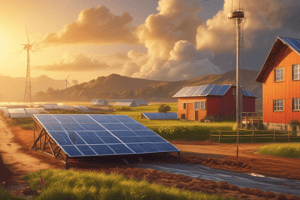Podcast
Questions and Answers
Agriculture plays a central role in meeting consumer and business market ______.
Agriculture plays a central role in meeting consumer and business market ______.
demand
Different types of products are derived from ______.
Different types of products are derived from ______.
agriculture
The practice of agriculture can be seen as an ______.
The practice of agriculture can be seen as an ______.
art
______ can be defined as field or land used for agricultural purposes.
______ can be defined as field or land used for agricultural purposes.
Signup and view all the answers
In a world with interconnected economies, agriculture helps meet ______ needs.
In a world with interconnected economies, agriculture helps meet ______ needs.
Signup and view all the answers
The basic concepts of agriculture include understanding the ______ and environment.
The basic concepts of agriculture include understanding the ______ and environment.
Signup and view all the answers
Meeting market demand through agriculture involves different ______.
Meeting market demand through agriculture involves different ______.
Signup and view all the answers
Agriculture is intertwined with various aspects of the ______ and environment.
Agriculture is intertwined with various aspects of the ______ and environment.
Signup and view all the answers
The introduction of basic concepts of agriculture and ______ is crucial for understanding its principles.
The introduction of basic concepts of agriculture and ______ is crucial for understanding its principles.
Signup and view all the answers
Products derived from agriculture are essential to meet consumer and business ______.
Products derived from agriculture are essential to meet consumer and business ______.
Signup and view all the answers
Study Notes
Introduction to Environmental Agriculture
- Course: ES 105 (Environmental Agriculture)
- Instructor: Elma B. Clacio
- Topic: Basic Concepts of Agriculture & Environment
Objectives
- Define agriculture
- Determine the importance of agriculture
- Identify the different branches and sectors of agriculture
- Define basic agricultural terminologies
Agriculture (Latin Roots)
- Agr(er) - Field
- Cultura - Cultivation
- Agriculture - Field or land tillage
Definition of Agriculture
- Agriculture is the science and art of cultivating the soil, including gathering crops and raising livestock (Oxford Dictionary, 1971).
- Agriculture is also the art, science, and business of cultivating crops and livestock for economic purposes. (Includes domestication and farming of plant and animal species)
Importance of Agriculture
-
Supporting livelihoods through food, habitat, and jobs
-
Providing raw materials for food and other products
-
Building strong economies through trade
-
Raw materials: lumber, herbs, corn (for ethanol), plant resins used in construction, coatings, and paints
-
Creating a strong supply chain requires methods, like ocean freight, rail, and trucking; delays impact the global supply chain.
-
Encouraging economic development because it's tied to other sectors of the economy, supports job creation, and encourages economic development
-
Countries with strong agricultural sectors experience: employment growth; agriculture productivity growth, and robust agriculture infrastructure
-
This leads to higher per capita incomes. Improved practices innovate through technology.
-
Meeting consumer and business market demand by providing essential products like fruits and vegetables
-
Fruits and vegetables provide fiber, protein, carbs, vitamins, minerals (magnesium, zinc, phosphorus)
-
Animal feed: fruits, vegetables (hay, straw, and legumes for poultry and livestock)
-
Natural rubber production: more than 1.4 billion vehicles require rubber tires; Thailand, Indonesia, and Malaysia collectively represent about 70% of global natural rubber production
-
Biofuels: favorable economics, produced from biomass (corn, soybeans, sugarcane, algae). Reduced greenhouse gas and pollutant emissions, potential increased incomes for farmers.
-
Important Role in Daily Life: provides essential resources for activities, including getting ready for the day, cooking, travel, medicine, and treatments.
-
Economic Impact on US Gross Domestic Product: this is from farm production, forestry, fishing activities, textile mills, apparel, food, beverages, and service and manufacturing.
Branches of Agriculture
- Livestock Production (Animal Husbandry): raises animals for meat, fiber, milk, eggs, or other products.
- Examples: poultry (raising chickens, ducks, turkeys), swine (raising pigs), nomadic pastoralism.
- Crop Production (Agronomy): Cultivation of crops (mostly annuals) under rain fed or irrigation conditions.
- Focuses on soil, climate, planting time/techniques, cultivars, fertilization, weed/disease/insect control, stress factors.
- Agricultural Economics: allocation, distribution, and utilization of resources used, agricultural commodities, production, consumption of food. (Developments, and policies affecting countries).
- Agricultural Engineering: Designs, construction, and improvement of farming equipment and machinery. (Agricultural infrastructure, pollution control, development of new biofuels from non-food resources)
Sectors of Agriculture
- Farming
- Fisheries
- Livestock
- Forestry
Terminologies in Agriculture
- Agroforestry
- Alley cropping
- Crop rotation
- High-input farming
- Corporate farming
- Intercropping
- Interplanting
- Low-input farming
- Monoculture
- Organic farming
- Plantation
- Polyculture
- Subsistence farming
- Tillage
- Cultivation
- Intensive farming
- Industrial herding
Studying That Suits You
Use AI to generate personalized quizzes and flashcards to suit your learning preferences.
Related Documents
Description
This quiz covers the basic concepts of agriculture and its relationship with the environment as taught in ES 105. You'll explore definitions, branches of agriculture, and understand its significance in society and economy. Test your knowledge on agricultural terminologies and their Latin roots.




